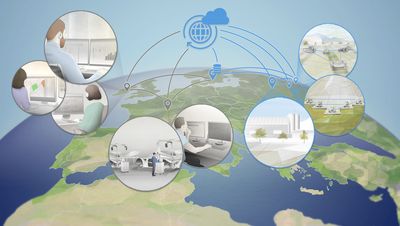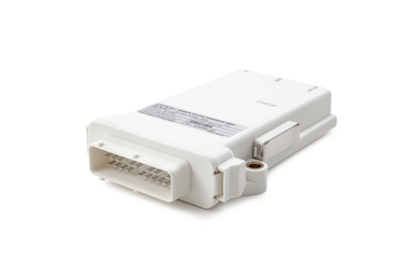The introduction of telematics services by a company is very often initially driven by requirements arising within technical support or maintenance teams. Only after a first implementation additional business opportunities are realized and the potential of telematics services as a business on its own is perceived. In addition the extent of the implementation has a significant impact on processes and organizational structures within the company. This leads to the conclusion that the step towards telematics services is rather a strategic top-down decision than a technical bottom-up approach. Manufacturers, integrators, or operators of diesel engines have been and will be confronted with this topic which his outlined in this article.
Very often the diesel engine is the heart of a mobile working machine or a mobile power generator. Basically, telematics services comprise the data communication, data storage, data analysis and computing, and data transmission within these mobile machines, between mobile machines (M2M) and between a machine and the infrastructure (Internet, server, or cloud) along with the presentation of according services. In order to make use of and to offer telematics services the technology for exchanging data remotely (M2M) had to be available in first place. Remote data transfer has been around for quite some time, probably nearly as long as remote communication is possible. Nevertheless, telematics services for mobile machines could be introduced only on a wider basis after the invention of today’s cellular networks which started in the late 20th century. As mobile working machines very often work in remote areas the additional prerequisite was a wide coverage and availability of these cellular networks. The next success factor for wider usage was the price of the necessary technical equipment. While by the end of the 20th century a price for a cellular modem was at roughly Euro/USD 100 (with support of dual-band GSM data rate of 9.6 kbit/s and text messages – SMS), we are looking at quad-band GSM/GPRS/EDGE modems at a tenth of this price with data rates of up to 85.6 kbit/s today. The new standards UMTS and LTE enable even much higher data transfer rates – with LTE we are looking at a downlink speed of 150 Mbit/s, 15.000 times the speed that was barely available not even 20 years ago. One example for a telematics unit that can be used in mobile machines is STW’s TC3G [picture]. Furthermore costs of operation came down and pan-European or even world-wide charging models for the data volumes are being offered. This all results in an available, mature, and affordable technology that can create advantages within the complete telematics ecosystem.
Data and interested parties
So the technological ground is laid for telematics services along with the data communication via the Internet, according data storage capacities either the traditional way or in the Cloud, and enough computing power to crunch all the data. In and around a diesel engine typically its operating status is monitored using pressure, temperature, torque and rpm sensors and compared to the nominal value given by a throttle control. At the same time the concentration of chemical substances in the exhaust is measured. There are plenty of values that are of interest to different groups amongst them the manufacturers. Their R&D team, technical support, and maintenance crew can take obvious advantage of services such as remote and probably preventive diagnosis. In the same way the operator of the machine will benefit from simple instruction communicated by these teams to keep his machine running or get it going again. Similarly interested in the usage and operation hours of his machine is the owner. He’s looking for return of his investment. In case of damages the insurance companies might be looking at diagnose data, to see if operation of the engine was according to specification. A service provider, who might not own the engine will need the data as well as his client who has to pay might like to check the bill after all. But not all of them will be allowed to see all data, so managing access to these data is essential, which involves security and safety, too.
A real-world example
At “BAUER Maschinen GmbH” based in Schrobenhausen, Germany, a telematics system had been developed and deployed with exactly this ecosystem in mind. “BAUER Maschinen GmbH”, which designs and manufactures rotary drilling rigs, diaphragm wall equipment and all related tools, has been operating on the market as an independent entity within the BAUER Group since 2001. But BAUER does not only build construction equipment, they also offer the construction service itself. With their daughter company “BAUER Spezialtiefbau GmbH” they concentrate mainly on the execution of complex special foundation works in difficult soil and can present the best references worldwide. In addition Bauer sells used machines or rents out machines. With webBGM BAUER implemented a teleservice which covers the aspects of their business including their OEM partners. The entities involved are typically OEM’s aftersales and technology departments, the lesser of the equipment, the repair shop, the machine operator, and the construction site management. Also here care was taken that data are safely and securely stored and access to the data is provided only to the relevant people. The services offered by webBGM therefore comprise a multitude of functions including the technical aspects with remote diagnose and remote update, cover the logistic with service and material planning and supervision of construction progress, and support accounting by issuing according bills. Moreover, one of the earliest telematics services – anti-theft protection and stolen equipment recovery – comes on top. The picture shows BAUER drilling rigs at the Laktha Tower construction site in St. Petersburg
A new landscape
Of course, implementing changes to this extend involves a couple of challenges. If though through in detail it is a transformation of the business model along with probably new sales channels. Selling a drilling rig is different from selling the complete execution. One has to face new technologies. It took electronic control systems a long time to evolve into some mobile working machines, now one has to deal with RF communication, security, M2M standards, linking to an ERP system and more. This will involve new partners such as ERP system suppliers, cellular network providers, and operators of servers and IoT platforms. Also the financial model will be different as licensing or pay-by-use models will pop up. Finally the legal aspect must not be underestimated. Who owns the data? Who has which access rights? The complete landscape changes, the company’s new offering will address new customers.
The revolution
Data are the new currency. The differentiation on a technological level keeps getting more difficult. Invention of new features is very often linked to a long process along with typically high costs at least in the ramp-up phase of a product. But price is a key factor. In addition initiatives like “Industry 4.0”, the fast changes in the consumer world and globalization will have machines and data merge more and more. Negligence of these trends might eliminate certain mobile working machines as a solution for a project. To support the trends a new class of computers will become established on the machines in order to support their counterparts in the back-office or Cloud. Along with this new standards like oneM2M have to be supported. Companies deciding for complete propositions, solutions, and services have a fair chance to define and create a complete market – like it happened and is still happening in the music industry, in the cellular mobile phone world, with watches. Data management offers the opportunity to widen a company’s portfolio by services. The market is there, the only question is who is first? As outlined above this is a long-term strategic decision and each company should consider, weigh and finally make it deliberately.
About STW:
STW is an internationally active company that has supported the world's leading manufacturers of mobile machines and industrial vehicles in the application of new technologies in automation, connectivity and e-mobility for over 30 years.
STW develops, manufactures and distributes a wide range of products for measurement and control, telematics and the electrification of the powertrain and implements. We also support the system conception, design and implementation.



